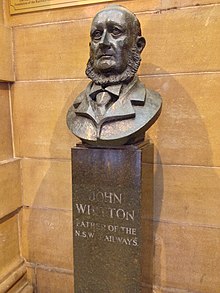John Whitton
| John Whitton | |
|---|---|

John Whitton bust at Central station
|
|
| Born | 1820 near Wakefield, Yorkshire, England |
| Died | 20 February 1898 Mittagong, New South Wales, Australia |
| Occupation | Civil engineer |
| Known for | Australian and English railway engineering |
| Spouse(s) | Elizabeth, née Fowler (m. 1856) |
John Whitton (1820, near Wakefield, Yorkshire, England – 20 February 1898), an Anglo–Australian railway engineer, was the Engineer-in-Charge for the New South Wales Railways, serving between 1856 and 1899, considered the Father of New South Wales Railways. Under his supervision, it is estimated that 2,171 miles (3,494 km) of railway around New South Wales and Victoria were completed. Whitton was responsible for the construction of the Blue Mountains railway line and parts of the Main Western railway line, in particular the Great Zig Zag near Lithgow, and much of the Great Southern line.
Indentured in England, Whitton gained extensive railway engineering experience prior to his arrival in the Colony of New South Wales in 1856. He was engineer for the Manchester, Sheffield and Lincoln railway line (1847), and supervised the building of the Oxford, Worcester and Wolverhampton line from 1852 to 1856.
Appointed in March 1856 as Engineer-in-Charge, Whitton arrived in Sydney and found the Colony with 23 miles (37 km) of 4 ft 8 1⁄2 in (1,435 mm) standard gauge railway, four locomotives, 12 passenger carriages and 40 trucks. An advocate of the 5 ft 3 in (1,600 mm) broad gauge adopted by Victoria and South Australia railways, Whitton set about extending the railway into the city and resisted pushes for 4,000 miles (6,400 km) of cheaper, light tramways, such as horse drawn lines with wooden rails, proposed by Governor William Denison. Whitton strongly opposed the government's uncritical acceptance of the lowest tenders for railway construction.
...
Wikipedia
